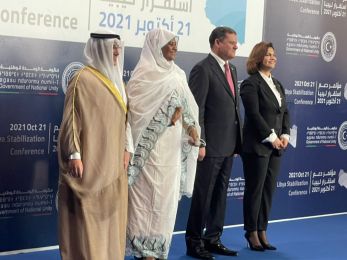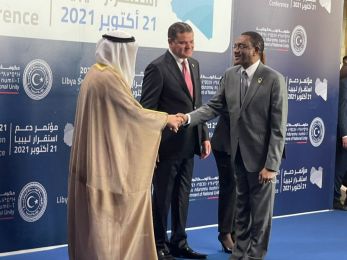PANAPRESS
Panafrican News Agency
Italy: 'At least 200 children lost at sea trying to reach Italian shores so far this year' - UNICEF
Taormina, Italy (PANA) - At least 200 children have died along the dangerous Central Mediterranean migration route from North Africa to Italy so far this year – a rate of more than one child per day – according to the latest estimates from UNICEF.
The updated child death figures come as leaders of G7 industrialized countries gather in Taormina, Sicily, an autonomous Region of Italy.
According to UNICEF, "Data for 2017 shows that an increasing number of refugees and migrants, including children, are taking the perilous Central Mediterranean route to reach Europe, despite the journey’s inherent risks. Between 1 January and 23 May, more than 45,000 refugees and migrants arrived to Italy by sea – an increase of 44 per cent over the same period last year. This includes some 5,500 unaccompanied and separated children – an increase of 22 per cent from 2016 – who account for approximately 92 per cent of all children arriving to Italy via the Central Mediterranean route."
“More children are braving the Central Mediterranean route to reach Italy which means that more children are literally dying to get there,” said UNICEF Deputy Executive Director Justin Forsyth. “A record high 26,000 unaccompanied and separated children arrived to Italy last year, but if current trends hold, that record will be smashed in 2017. That is not a record to be proud of, but a reminder of our collective failure to ensure the safety and wellbeing of refugee and migrant children.”
Earlier on Thursday, the eve of the G7 Summit, children, volunteers, the Italian coastguard, Italian and UNICEF officials took part in a symbolic rescue of paper boats to commemorate the thousands of children who have risked their lives crossing the Central Mediterranean and send a message to the G7 to take action to safeguard children on the move.
At least 36,000 of the refugees and migrants rescued since January have been taken to Sicily, the site of the 2017 summit, and the Italian G7 Presidency has made migration a priority for this year’s talks.
“Sicily stands as a symbol of hope for uprooted children seeking a better life, but it is also the endpoint of an extremely dangerous journey that has claimed the lives of many children along the way,” said Forsyth. “It is fitting then that G7 leaders are meeting in a place so steeped in symbolism and meaning for what has become one of the greatest crises of our time. This is their moment to show true leadership in adopting a concrete policy plan that will help keep refugee and migrant children safe.”
In the run-up to the G7 Summit, UNICEF has met the G7 Sherpas in their capitals, urging them to support Italy’s leadership and to adopt the UNICEF six-point Agenda for Action for the protection of refugee and migrant children.
The agenda includes:
1. Protect child refugees and migrants, particularly unaccompanied children, from exploitation and violence;
2. End the detention of children seeking refugee status or migrating, by introducing a range of practical alternatives;
3. Keep families together as the best way to protect children and give children legal status;
4. Keep all refugee and migrant children learning and give them access to health and other quality services;
5. Press for action on the underlying causes of large scale movements of refugees and migrants;
6. Promote measures to combat xenophobia, discrimination and marginalization in countries of transit and destination.
In addition to the Agenda for Action, UNICEF has also launched a campaign urging the public to stand in solidarity with refugee and migrant children uprooted by war, violence and poverty.
The “#AChildIsAChild” campaign, featuring a large billboard in the centre of Taormina with the message ‘G7 Leaders, protect migrant and refugee children’, has so far been supported on social media by more than 2 million people.
-0- PANA VAO 26May2017
The updated child death figures come as leaders of G7 industrialized countries gather in Taormina, Sicily, an autonomous Region of Italy.
According to UNICEF, "Data for 2017 shows that an increasing number of refugees and migrants, including children, are taking the perilous Central Mediterranean route to reach Europe, despite the journey’s inherent risks. Between 1 January and 23 May, more than 45,000 refugees and migrants arrived to Italy by sea – an increase of 44 per cent over the same period last year. This includes some 5,500 unaccompanied and separated children – an increase of 22 per cent from 2016 – who account for approximately 92 per cent of all children arriving to Italy via the Central Mediterranean route."
“More children are braving the Central Mediterranean route to reach Italy which means that more children are literally dying to get there,” said UNICEF Deputy Executive Director Justin Forsyth. “A record high 26,000 unaccompanied and separated children arrived to Italy last year, but if current trends hold, that record will be smashed in 2017. That is not a record to be proud of, but a reminder of our collective failure to ensure the safety and wellbeing of refugee and migrant children.”
Earlier on Thursday, the eve of the G7 Summit, children, volunteers, the Italian coastguard, Italian and UNICEF officials took part in a symbolic rescue of paper boats to commemorate the thousands of children who have risked their lives crossing the Central Mediterranean and send a message to the G7 to take action to safeguard children on the move.
At least 36,000 of the refugees and migrants rescued since January have been taken to Sicily, the site of the 2017 summit, and the Italian G7 Presidency has made migration a priority for this year’s talks.
“Sicily stands as a symbol of hope for uprooted children seeking a better life, but it is also the endpoint of an extremely dangerous journey that has claimed the lives of many children along the way,” said Forsyth. “It is fitting then that G7 leaders are meeting in a place so steeped in symbolism and meaning for what has become one of the greatest crises of our time. This is their moment to show true leadership in adopting a concrete policy plan that will help keep refugee and migrant children safe.”
In the run-up to the G7 Summit, UNICEF has met the G7 Sherpas in their capitals, urging them to support Italy’s leadership and to adopt the UNICEF six-point Agenda for Action for the protection of refugee and migrant children.
The agenda includes:
1. Protect child refugees and migrants, particularly unaccompanied children, from exploitation and violence;
2. End the detention of children seeking refugee status or migrating, by introducing a range of practical alternatives;
3. Keep families together as the best way to protect children and give children legal status;
4. Keep all refugee and migrant children learning and give them access to health and other quality services;
5. Press for action on the underlying causes of large scale movements of refugees and migrants;
6. Promote measures to combat xenophobia, discrimination and marginalization in countries of transit and destination.
In addition to the Agenda for Action, UNICEF has also launched a campaign urging the public to stand in solidarity with refugee and migrant children uprooted by war, violence and poverty.
The “#AChildIsAChild” campaign, featuring a large billboard in the centre of Taormina with the message ‘G7 Leaders, protect migrant and refugee children’, has so far been supported on social media by more than 2 million people.
-0- PANA VAO 26May2017






